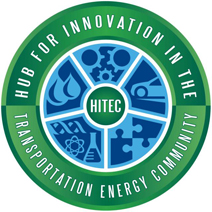
Recognizing the need for new energy solutions in the transportation sector that balance climate, security, and sustainability, Sandia has launched a new, Labs-wide venture aimed at filling this void through large-scale public-private partnerships with an array of domestic and international research institutions and programs.
Known as the Hub for Innovation in the Transportation Energy Community (HITEC), the effort will focus on vehicle engine efficiency, vehicle electrification, and low-carbon alternative fuels, all with an underpinning of systems analysis. The new initiative is led by Transportation Energy Center 8300 Director Bob Carling and his deputy Andy McIlroy, who are identifying potential industry, national laboratory, and university partners via personal contacts and state, national, and international conferences and events.
“We’re aggressively reaching out to the private sector and other entities that can join HITEC and help bridge the gaps between research, policy, and the marketplace for transportation energy,” says Andy.
Bob says HITEC, with the Combustion Research Facility (CRF) as its core, is being developed in parallel with the National Energy Innovation Initiative (NEII), spearheaded by Terry Michalske (6100). Other members of the HITEC senior management team include Bob Hwang (1130), Justine Johannes (1811), Cara Johnson (2540), John Merson (6310), Pat Falcone (8110), Denise Koker (8520), and Art Pontau (8360). Still, even as Sandia leads the effort, Bob says HITEC won’t necessarily be “owned” or directed by Sandia. Those responsibilities, he says, will be shared with HITEC partners.
First steps
In January, members of the HITEC team, largely composed of staff members in the business development support group (8529), actively participated in a series of overseas conferences and meetings with a variety of international companies and potential HITEC partners, including BP Alternative Energy, Ricardo, and Lotus Engineering. In addition, Sandia and HITEC served as sponsors at a recent transportation energy conference organized by CALSTART (a California-based organization dedicated to supporting and accelerating the growth of the advanced transportation technologies industry and its related markets). Groups like CALSTART could help broker even more key relationships, especially with companies in the state of California.
In addition to the outreach to industry, HITEC team members Bruce Balfour, Jill Micheau, Craig Smith, and Carrie Burchard (all 8529) have been researching other public-private partnership models that successfully mirror HITEC. Bruce and Jill, for instance, visited the Science and Enterprise Park at Loughborough University in Loughborough, UK, and met with the management of the Energy Technologies Institute (ETI) and Cenex, the UK’s Centre of Excellence for Low Carbon and Fuel Cell Technologies. Their hosts, Bruce said, proved very helpful in explaining the inner workings of ETI’s organizational structures and lessons learned in running an industry-driven public-private partnership.
R&D — and D
While Sandia tends to be very adept at traditional research and development, Bob says HITEC aims to add another D — demonstration — to the familiar “R&D.”
“Much like a recent General Motors project — which entailed science-based engineering and demonstration of a hydrogen fuel system — one of HITEC’s objectives will be to produce viable, real-world transportation energy solutions that can bridge the gap between research labs and commercial products,” says Bob.
“HITEC partners will include US and international transportation companies, energy firms, research organizations, and universities, as well as other DOE laboratories,” says Bob. The first order of business, he points out, is to identify representatives from a group of flagship partners who will form the basis of a steering committee. That team, Bob says, will help select the specific areas of research on which HITEC will focus, develop a workable funding structure, and help guide other hub decisions and priorities. Though no partners have yet committed to the venture, letters of support have been signed by several entities, and follow-up meetings are planned with several potential partners.
‘Open campus’ and other synergies
In the future, facilities and space for HITEC could come into play as the Livermore Valley’s “Open Campus” begins to come to fruition. Sandia and Lawrence Livermore Lab are creating the campus, which will allow greater international scientific engagement, enable closer interaction with industry and academia, and spur local economic development by providing opportunities for start-ups and technical spin-offs.
As currently envisioned, the proposed open campus will be anchored by two facilities, an LLNL-led International Center for High Energy Density Science and the Sandia-led HITEC. In a separate venture that could create additional synergies, the city of Livermore is also considering the creation of a technology park in an area near the campus.
Though he’s optimistic about the energy and enthusiasm surrounding the HITEC launch, Bob says a number of issues still need to be resolved before it’s a viable program.
“Through what channels can we most effectively articulate the benefits of HITEC to potential partners? What role will we define for academia? We believe we’ve got an excellent value proposition to offer, and we intend to enhance it as we continue to engage our partners,” says Bob.
Bob believes the foundation for a successful HITEC venture is in place at Sandia. “The timing couldn’t be better,” he says. “There’s a clear need, a new secretary of energy, and a new administration that has stated a commitment to energy security and innovation in transportation energy. Sandia has a distinctive blend of capabilities that make us an ideal entity to lead this effort. I expect us to succeed.”
Those interested in learning more about HITEC are invited to visit its website at: www.HITECtransportation.org